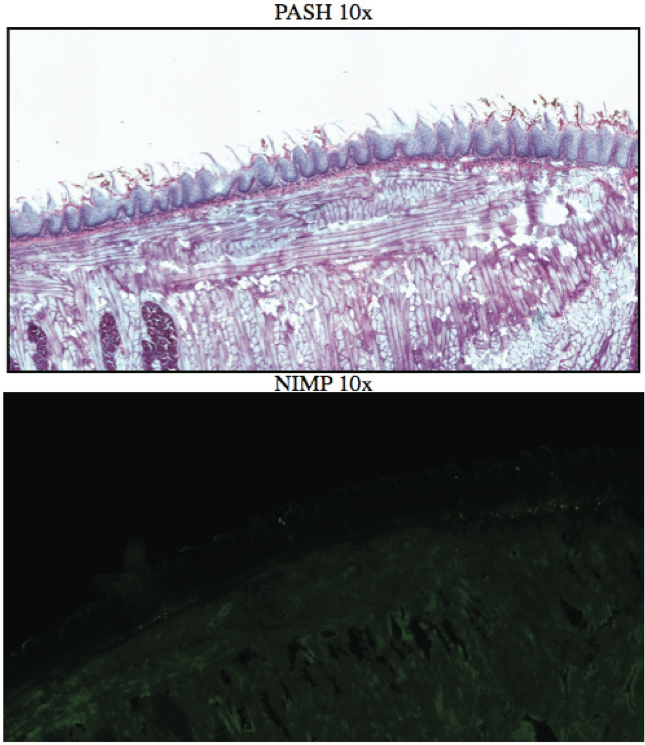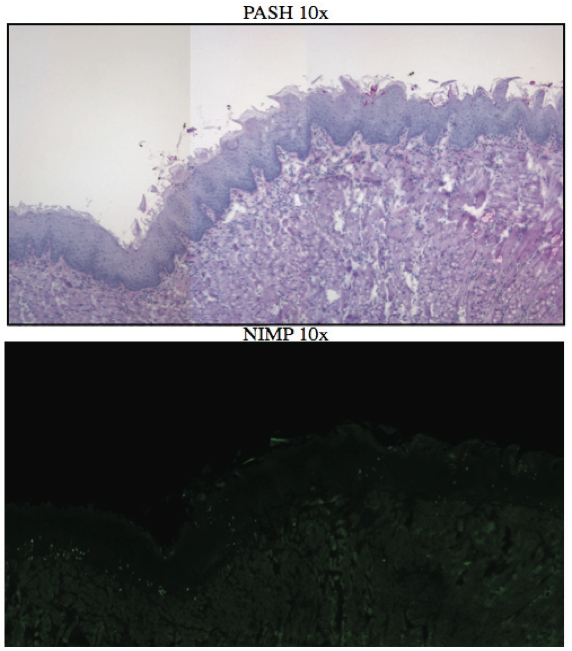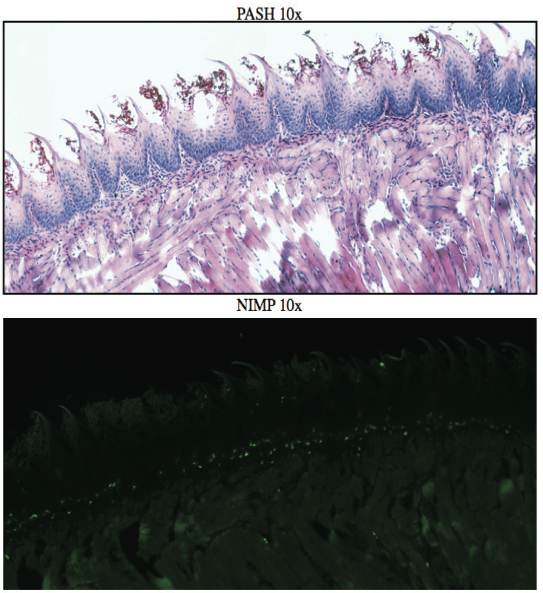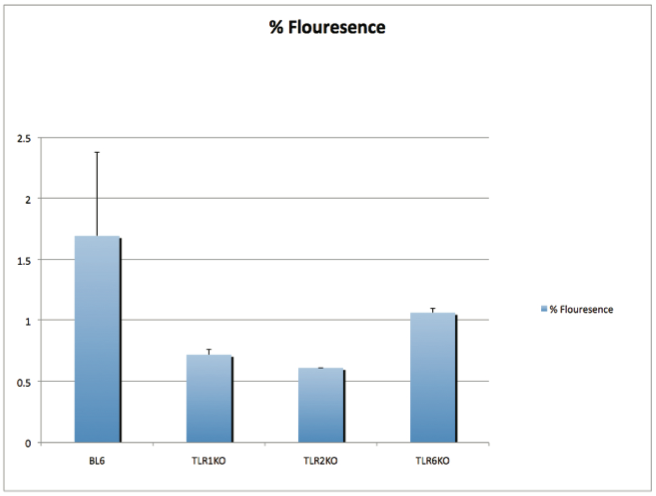From Discussions VOL. 5 NO. 2The Role of Innate Receptor TLR2 in Neutrophil Recruitment in Oropharyngeal Candidiasis (OPC)Results & DiscussionUsing NIMP/Alexa488 staining, we visualized neutrophil recruitment in the tongues of different OPC infected TLRKO mice and compared them to the BL6 mouse control. In addition to qualitative assessment done with the fluorescent microscope, we used the analytical program, Metamorph. With Metamorph we quantified our results in order to better analyze the neutrophil recruitment in the tongue epithelium. Figure 1 displays PASH staining and neutrophil staining of a BL6 mouse. Image A displays the PASH stain showing the tongue histology. Part 'i' shows the muscle and blood vessel tissue, 'ii' shows the superior epithelium of the tongue, 'iii' shows the outer most layer of the tongue the stratum corneum that consists of keratinized oral mucosa1, and finally 'iv' shows the C. albicans infiltration and growth on the surface of the tongue. Images B & C show 10x and 20x images of NIMP/Alexa488 staining of that same location on a serial section of the tongue. The green fluorescence corresponded to neutrophil specific staining. Finally, image D shows a superimposed NIMP/Alexa488 and DAPI staining. DAPI stain is a DNA specific fluorescent stain, hence the blue fluorescence in this image corresponds to all the nuclei in the image. Looking at the neutrophil nuclei we can visualize the polymorphonuclear properties of these cells confirming that our NIMP/Alexa488 stain corresponded to neutrophils. Figure 1: Sections of C57BL/6 OPC infected mouse tongue epithelium tissue, stained with PASH stain to show histology and C. albicans growth, and NIMP/Alexa488 and DAPI stain on the neighboring tongue section to show nuetrophil migration and nucleus placement. A) PASH stain of tongue epithelium (blue) C. albicans is seen on the top of the epithelium (magenta). B) corresponding tongue section with NIMP/Alex488 (green). Neutrophils fluoresce green and are migrating to the site of C. albicans infection. C) 20x image of the same section. D) Same section with NIMP/Alexa488 (green) stain and DAPI (blue) stain.
Figures 2, 3, 4 and 5 display PASH and NIMP/ Alexa488 staining of OPC infected tongues for BL6, TLR1KO, TLR2KO, and TLR6KO mice respectfully. Qualitatively we saw a trend of a much weaker neutrophil recruitment response to the C. albicans infection in all of the gene knockout mice compared to the BL6 control. Also we noticed another trend where the C. albicans growth and epithelium infiltration were more prominent on the tongues of the TLR1KO, and TLR6KO mice. We used Metamorph to calculate the presence of fluorescence for each of the tongue sections stained. We then calculated average percent of fluorescence for each mouse genotype and we graphed the values in Figure 6. Our results are consistent with our qualitative analysis of the staining; we saw a negative trend in neutrophil recruitment with any of the knockout mice. We saw the lowest percent of fluorescence in our TL2KO mouse. The calculated fluorescence value for the TLR2KO mouse was 0.61% compared to the average 1.7% fluorescence of the Bl6 control mice. TLR2 is a cell surface receptor present on neutrophils. It has been implicated in the recognition of the lipopeptide phospholipomannan, a component C. albicans. The neutrophils in TLR2KO mouse lack this surface receptor and hence the ability for them to migrate to the site of the C. albicans infection becomes severally hindered. Figure 2: Sections of C57BL/6 OPC infected mouse tongue epithelium tissue, stained with PASH stain to show histology and C.albicans growth, and NIMP/Alexa488 stain on the neighboring tongue section to show neutrophil migration.
Our TLR1KO, and TLR6KO mice also had hindered neutrophil recruitment, 0.72% and 1.1% respectfully. Both TLR1 and 6 form heterodimers with TLR2 to provide it with ligand specificity. TLR2/TLR1 heterodimers recognize triacyl lipopeptides, and TLR2/TLR6 heterodimers recognize diacyl lipopeptides10. When comparing the fluorescence values of both genotypes there was less neutrophil recruitment in the TLR1KO mouse, which means that there was a larger number of triacyl lipopeptide ligands involved in the recruitment of neutrophils, however more thorough research is needed. None of the gene knockout mice dis- played zero fluorescence/neutrophil recruit- ment. This suggests that the signaling path- way for neutrophil recruitment is not solely dependent on either TLR1, 2, or 6 and that neutrophil recruitment is not dependent on one signaling pathway. In a preliminary study, we observed very little to no fluorescence in a NIMP/Alexa488 stained MyD88KO mouse tongue section. This is an indication that MyD88 might be responsible for a signaling pathway that may or may not directly involve TLRs. In the future, studies will include a larger sample size to give more significant results. Additional studies will further characterize the role of MyD88 and C-type lectin receptor Dectin-1, a receptor believed to collaborate with TLRs11, in neutrophil recruitment to a candidiasis infection. AcknowledgmentsI would like to thank Dr. Amy Hise and her staff for helping me throughout the duration of my research. I would also like to thank Dr. Ronald Oldfield for advising me throughout this process, and Dr. Scott Howell for training me on how to use the fluorescent microscope and imaging software. References
Figure 3: Sections of TLR1KO OPC infected mouse tongue epithelium tissue, stained with PASH stain to show histology and C. albicans growth, and NIMP/Alexa488 stain on the neighboring tongue section to show neutrophil migration.
Figure 4: Sections of TLR2KO OPC infected mouse tongue epithelium tissue, stained with PASH stain to show histology and C.albicans growth, and NIMP/Alexa488 stain on the neighboring tongue section to show neutrophil migration.
Figure 5: Sections of TLR6KO OPC infected mouse tongue epithelium tissue, stained with PASH stain to show histology and C.albicans growth, and NIMP/ Alexa488 stain on the neighboring tongue section to show neutrophil migration.
Figure 6: The average percent fluorescence for each of BL6, TLR1KO, TLR2KO, TLR6KO OPC infected mice and their corresponding sample sizes (n). The fluorescing corresponds to the neutrophils in the tongue sections from the NIMP/Alexa488 staining. The percent of fluorescence was calculated by dividing the number of fluorescing pixels by the total number of pixels in the 10xstitched images in the program Metamorph.
Suggested Reading from Inquiries Journal
Inquiries Journal provides undergraduate and graduate students around the world a platform for the wide dissemination of academic work over a range of core disciplines. Representing the work of students from hundreds of institutions around the globe, Inquiries Journal's large database of academic articles is completely free. Learn more | Blog | Submit Latest in Biology |





























